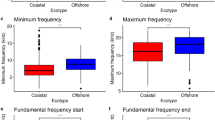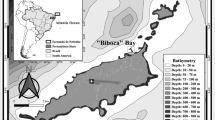Abstract
The Guiana dolphin produces a variable whistle repertoire related to different social contexts. The current study evaluates Guiana dolphin whistles at a microscale. Acoustic parameters of whistles were compared between three areas in southeastern Brazil using a recording system with sampling rate of 96 kHz. Previous studies that utilized a sampling rate of 48 kHz reported little variation between adjacent areas in Brazil. Nine acoustic parameters of the whistles (duration, start, end, minimum and maximum frequencies, delta frequency, frequency at 1/4, 1/2, and 3/4 of duration) were measured and whistles were classified into five contour forms. A total of 659 whistles were analyzed, of which 62.20 % showed an ascending contour form. The Guiana dolphin emitted whistles with a fundamental frequency reaching 44.9 kHz. Dolphin whistles from the three study areas varied significantly in nine acoustic parameters. The whistle duration was shorter (272.44 ± 105.25 ms) in Guanabara Bay than those in Sepetiba (360.05 ± 135.16 ms) and Paraty Bays (376.80 ± 159.78 ms). The start and minimum frequencies of the whistles in Guanabara Bay was significantly higher than those in Sepetiba and Paraty Bays. The results of discriminant function analysis indicated a significant difference between Guanabara Bay and the other two areas. Comparisons of the ascending, descending–ascending, and multi whistles between areas showed differences in some acoustic parameters. In this study, by doubling the sampling rate in our recording systems, we were able to more accurately sample the whistle repertoire of Guiana dolphins in southeastern Brazil, and thereby detect differences in whistles between neighboring populations.



Similar content being viewed by others
References
Ansmann IC, Goold JC, Evans PGH, Simmonds M and Keith SG (2007) Variation in the whistle characteristics of short-beaked common dolphins, Delphinus delphis, at two locations around the British Isles. J. Mar. Biol. Ass. U.K. 87:19–26.
Au WWL and Hasting MC (2008) Principles of marine bioacoustics. Springer, Chap. 5, pp. 121–174
Azevedo AF, Simão SM (2002) Whistles produced by marine tucuxi dolphins Sotalia fluviatilis in Guanabara Bay, southeastern Brazil. Aquat Mamm 28:261–266
Azevedo AF, Van Sluys M (2005) Whistles of tucuxi dolphins (Sotalia fluviatilis) in Brazil: comparisons among populations. J Acoust Soc Am 117:1456–1464
Azevedo AF, Lailson-Brito JJ, Cunha HA, Van Sluys M (2004) A note on site fidelity of marine tucuxis (Sotalia fluviatilis) in Guanabara Bay, southeastern Brazil. J Cet Res Man 6(3):265–268
Azevedo AF, Viana SC, Oliveira AM, Van Sluys M (2005) Group characteristics of marine tucuxis (Sotalia fluviatilis) (Cetacea: Delphinidae) in Guanabara Bay, southeastern Brazil. J Mar Biol Ass U K 85:209–212
Azevedo AF, Oliveira AM, Viana SC and Van Sluys M. (2007). Habitat use by marine tucuxis (Sotalia guianensis) (Cetacea: Delphinidae) in Guanabara Bay, south-eastern Brazil. J. Mar. Biol. Ass. U.K. 87: 201–205.
Bazúa-Durán MC (2004) Differences in the whistle characteristic and repertoire of bottlenose and spinner dolphins. An Bras Acad Scien 76:386–392
Bazúa-Durán MC, Au WWL (2002) Whistles of Hawaiian spinner dolphins. J Acoust Soc Am 112:3064–3072
Bazúa-Durán MC, Au WWL (2004) Geographic variations in the whistles of spinner dolphins (Stenella longirostris of the main Hawaiian Islands. J Acoust Soc Am 116:3757–3769
Buckstaff K (2004) Effects of watercraft noise on the acoustic behavior of bottlenose dolphins, Tursiops truncatus, in Sarasota Bay, Florida. Mar Mamm Sci 20:709–725
Caldwell MC, Caldwell DK, Tyack PL (1990) Review of the signature-whistle hypothesis for the Atlantic bottlenose dolphin. In: Leatherwood S, Reeves RR (eds) The bottlenose dolphin. Academic, San Diego, pp 199–234
Deecke VB, Janik VM (2006) Automated categorization of bioacoustic signals: avoiding perceptual pitfalls. J Acoust Soc Am 119:645–653
Díaz López B (2011) Whistles characteristics in free-ranging bottlenose dolphins (Tursiops truncatus) in the Mediterranean Sea: influence of behaviour. Mamm Biol 76:180–189
Erber C, Simão SM (2004) Analysis of whistles produced by the tucuxi dolphin Sotalia fluviatilis from Sepetiba Bay, Brazil. Ann Acad Bras Sci 76:381–385
Figueiredo LD, Simão SM (2009) Possible occurrence of signature whistles in a population of Sotalia guianensis (Cetacea, Delphinidae) living in Sepetiba Bay, Brazil. J Acoust Soc Am 126:1563–1569
Flach L, Flach P, Chiarello A (2008) Aspects of behavioral ecology of Sotalia guianensis in Sepetiba Bay, southeast Brazil. Mar Mamm Sci 24:503–515
Herzing DL (2000) Acoustics and social behavior of wild dolphins: implications for a sound society. In: Au WWL, Popper AN, Fay RE (eds) Hearing by whales and dolphins. Springer, London, pp 225–272
Janik VM (2009) Acoustic communication in delphinids. Adv Stud Behav 40:123–157
Janik VM, Sayigh LS (2013) Communication in bottlenose dolphins: 50 years of signature whistle research. J Comp Psychol 199:479–489
Janik VM, Slater PJB (1998) Context-specific use suggests that bottlenose dolphin signature whistles are cohesion calls. An Behav 56:829–838
Janik VM, Dehnhardt G, Todt D (1994) Signature whistle variations in a bottlenosed dolphin, Tursiops truncatus. Behav Ecol Soc 35:243–248
Janik VM, King SL, Sayigh LS, Wells RS (2013) Identifying signature whistles from recordings of groups of unrestrained bottlenose dolphins (Tursiops truncatus). Mar Mammal Sci 29:109–122
Lodi L (2003) Tamanho e composição de grupo dos botos-cinza, Sotalia guianensis (van Bénéden, 1864) (Cetacea, Delphinidae), na Baía de Paraty, Rio de Janeiro, Brasil. Atlantica 25(2):135–146
Matthews JN, Rendell LE, Gordon JCD, Macdonald DW (1999) A review of frequency and time parameters of cetacean tonal calls. Bioacoustics 10:47–71
May-Collado LJ, Wartzok D (2008) A comparison of bottlenose dolphin whistles in the Atlantic Ocean: factors promoting whistles variation. J Mamm 89:1229–1240
May-Collado LJ, Wartzok D (2009) A characterization of Guiana dolphin (Sotalia guianensis) whistles from Costa Rica: the importance of broadband recording systems. J Acoust Soc Am 125:1202–1213
May-Collado LJ, Agnarsson I, Wartzok D (2007) Reexamining the relationship between body size and tonal signals frequency in whales: a comparative approach using a novel phylogeny. Mar Mamm Sci 23:524–552
Monteiro-Filho ELA, Monteiro KDKA (2001) Lowfrequency sounds emitted by Sotalia fluvialitis guianensis (Cetacea: Delphinidae) in an estuarine region in southeastern Brazil. Can J Zool 79:59–66
Morisaka T, Shinohara M, Nakahara F, Akamatsu T (2005) Effects of ambient noise on the whistles of indo-pacific bottlenose dolphin populations. J Mamm 86:541–546
Oswald JN, Rankin S, Barlow J (2004) The effect of recording and analysis bandwidth on acoustic identification of delphinid species. J Acoust Soc Am 116:3178–3185
Pivari D, Rosso S (2005) Whistles of small groups of Sotalia fluviatilis during foraging behavior in southeastern Brazil. J Acoust Soc Am 118:2725–2731
Podos J, Da Silva VMF, Rossi-Santos MR (2002) Vocalizations of Amazon river dolphins, Inia geoffrensis: Insights into evolutionary origins of Delphinidae whistles. Ethology 108:1–12
Quick NJ, Janik VM (2008) Whistle rates of wild bottlenose dolphins: influences of group size and behavior. J Comp Psychol 122:305–311
Rendell LE, Mathews JN, Gill A, Gordon JCD, Macdonald DW (1999) Quantitative analysis of tonal calls from five odontocete species, examining interspecific and intra-specific variation. J Zool Lon 249:403–410
Richardson WJ, Greene CRJ, Malme CI and Thomsom DH (1995). Marine mammals and noise. Academic, New York, Chap. 7, pp. 159–202
Rossi-Santos M, Podos J (2006) Latitudinal variation in whistle structure of the estuarine dolphin Sotalia guianensis. Behaviour 143:347–364
Schultz KW, Corkeron PJ (1994) Interspecific differences in whistles produced by inshore dolphins in Moreton Bay, Queensland, Australia. Can J Zoo 72:1061–1068
Steiner WW (1981) Species-specific differences in pure tonal whistle vocalizations of five western North Atlantic dolphin species. Behav Ecol Soc 9:241–246
Tyack PL (2000) Functional aspects of cetacean communication. In: Cetacean societies: field studies of dolphins and whales. Mann J, Connor RC, Tyack PL and Whitehead H (ed) University of Chicago Press, pp. 270–307.
Van Parijs SM, Corkeron PJ (2001) Vocalizations and behaviour of Pacific humpback dolphins, Sousa chinensis. Ethology 107:701–716
Wang DW, Wursig B and Evans WE (1995a) Comparisons of whistles among seven odontocete species, In: sensory systems of aquatic mammals. Kastelien RA, Thomas JA, Nachtigal PE, Holanda, pp. 299–323
Wang DW, Wursig B, Evans WE (1995b) Whistles of bottlenose dolphins: comparisons among populations. Aquat Mamm 21:65–77
Zar JH (1999) Biostatistical analysis. Prentice Hall, New Jersey, pp 196–200
Acknowledgments
This study was supported by a technical cooperation grant between Petrobras, UERJ, and ACPNR (4600–271434), as well as from Cetacean Society International (CSI). The authors thank the School of Oceanography (FAOC, UERJ) for logistical support. We also thank engineer Orlando de Jesus Ribeiro Afonso from the Brazilian Navy Research Institute (IPqM) for technical support. The authors thank the Graduate Program of Ecology and Evolution (PPGEE, UERJ) for support. We particularly thank Régis Pinto de Lima, Adriana Nascimento Gomes, Sylvia Chada, and Sílvia Peixoto from the Tamoios Ecological Station (ESEC Tamoios-ICMBio) for fieldwork logistics in Paraty Bay. This study was partially funded by the Brazilian Research Council (CNPq-Brazil; Edital Universal No. 476255/2007-4). Dr. Azevedo has a research grant from CNPq (grant No. 304826/2008-1). Dr. Lailson-Brito is a researcher of “Prociência” Program—FAPERJ/UERJ. Thanks to researchers and students of the Aquatic Mammal and Bioindicator Laboratory (MAQUA, UERJ).
Author information
Authors and Affiliations
Corresponding author
Rights and permissions
About this article
Cite this article
de Andrade, L.G., Lima, I.M., da Silva Macedo, H. et al. Variation in Guiana dolphin (Sotalia guianensis) whistles: using a broadband recording system to analyze acoustic parameters in three areas of southeastern Brazil. acta ethol 18, 47–57 (2015). https://doi.org/10.1007/s10211-014-0183-7
Received:
Revised:
Accepted:
Published:
Issue Date:
DOI: https://doi.org/10.1007/s10211-014-0183-7




